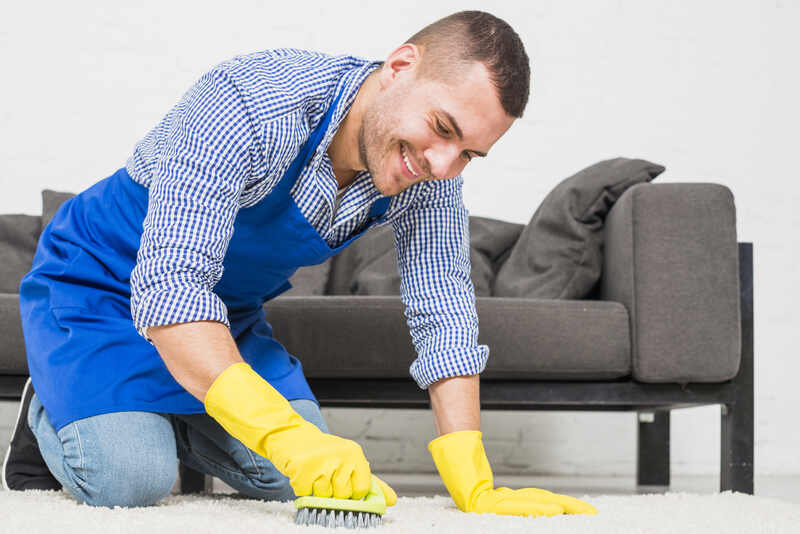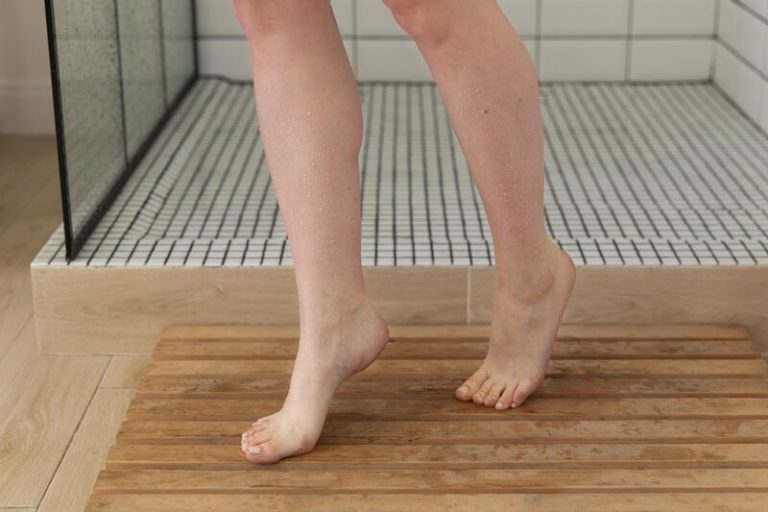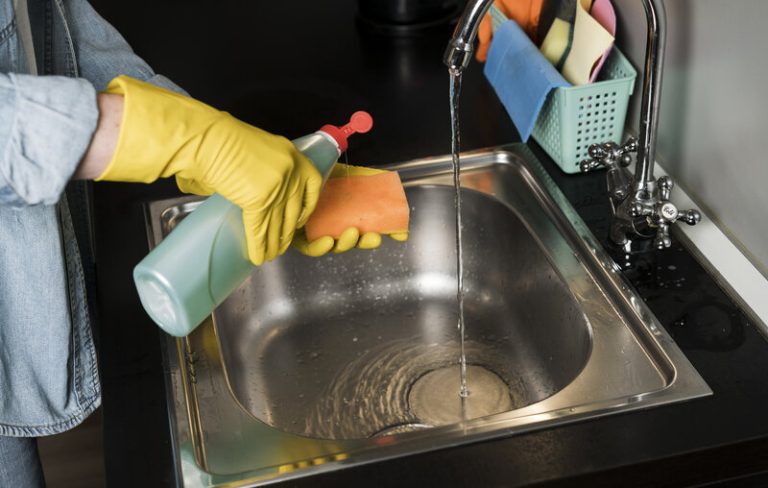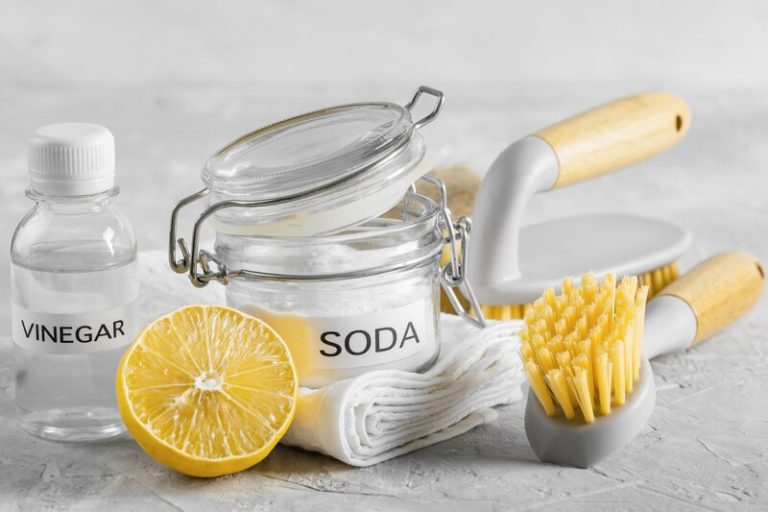Are you curious and looking for how to clean carpets without machine? Well, this article is for you.
We will explore various methods and tips for DIY carpet cleaning without a machine so that it stays clean and fresh.
From using simple household ingredients like baking soda and vinegar to tackling specific stains like pet accidents and wine spillages, we’ve got you covered.
Discover how to clean carpets without a machine easily and effectively to care for your carpets.
How To Clean Carpets Without Machine?
There are several effective methods for cleaning carpets without a machine, using readily available household items like vinegar, water, and bicarbonate of soda. Here is a further explanation of the various methods of how to clean carpet without machine.
a. Using Baking Soda and Vinegar
One effective method for cleaning carpets without a machine involves using a mixture of bicarbonate of soda and vinegar, which works well for tackling stubborn stains.
Start by sprinkling a generous amount of bicarbonate of soda over the stained area on the carpet. This helps in absorbing moisture and odours.
Next, mix equal parts of vinegar and water in a spray bottle. Spray the solution over the bicarbonate of soda until it creates a foaming reaction. Let the mixture sit on the carpet for at least 30 minutes to an hour to break down the stain.
After that, use a scrubbing brush or a damp cloth to gently scrub the area, working from the outside towards the centre to lift the stain effectively.
b. Using Dish Soap and Water
Before you begin, clear the area you intend to clean by removing any furniture or objects on the carpet. This ensures you can reach all areas and clean thoroughly. Next, vacuum the carpet to remove loose dirt, dust, and debris. This step is crucial as it prevents dirt from embedding deeper into the carpet fibres during the cleaning process.
In a large bowl or bucket, mix a few drops of dish soap with warm water. Be careful not to use too much soap, as excess soap can be difficult to rinse out and may leave a residue on your carpet. A good ratio is about 1-2 teaspoons of dish soap per gallon of water.
Before applying the solution to the entire carpet, it’s wise to do a spot test. Apply a small amount of the solution to an inconspicuous area of the carpet and blot it with a white cloth. Check the cloth for any colour transfer from the carpet and inspect the treated area for any discolouration. If there’s no colour transfer or damage, it’s safe to proceed.
Dip a clean cloth or sponge into the soapy water solution. Wring out any excess water to avoid over-wetting the carpet. Gently blot the stained or soiled areas of the carpet, working from the outside in to prevent the stain from spreading. Avoid scrubbing vigorously as this can damage the carpet fibers.
After you’ve treated the stains, it’s important to rinse the carpet to remove any soap residue. Fill a clean bucket with plain water and use a new cloth or sponge to blot the soapy areas. Again, ensure you wring out excess water to avoid soaking the carpet.
Once you’ve finished rinsing, use dry towels to blot up as much moisture as possible. Lay the towels over the damp areas and press down to absorb water. You can also place a fan near the treated area to speed up the drying process. Ensure the carpet dries completely to prevent mould and mildew growth.
c. Using Club Soda and Salt
Using soda water and salt is an excellent method for spot-cleaning carpets, particularly for removing fresh stains without requiring a machine.
To effectively apply soda water to a stained area on your carpet, start by pouring a small amount directly onto the spot. Allow the soda water to sit for a few minutes to loosen the stain. Next, sprinkle salt over the dampened area. The salt will help absorb the stain and lift it from the carpet fibres.
After letting it sit for a while, gently blot the spot with a clean cloth or kitchen roll. Repeat the process until the stain is removed, and then allow the carpet to air dry completely. This natural cleaning method is straightforward yet highly effective for dealing with fresh marks on your carpet.
d. Using Hydrogen Peroxide and Dish Soap
For a deeper clean, a combination of hydrogen peroxide and washing-up liquid can be used to tackle tough stains on carpets without the need for a machine.
Mixing these two powerful agents creates a potent cleaning solution. Start by combining one part hydrogen peroxide with one part washing-up liquid in a bowl or spray bottle.
Once the solution is ready, apply it generously to the stained areas of the carpet. Use a sponge or cloth to gently dab and distribute the mixture over the affected spots.
After allowing the solution to sit for a few minutes, take a brush or scrubbing tool and work it into the carpet fibres. Be thorough but gentle to avoid damaging the carpet.
Tips for Cleaning Specific Carpet Stains Without a Machine
Carpet cleaning without machine requires tailored approaches and expert tips to effectively remove each type of stain. Here is a more detailed explanation of the best way to clean carpets without a machine for different types of stains
a. Removing Pet Stains
To remove pet stains from carpets, a mixture of vinegar and bicarbonate of soda can be highly effective in neutralising odours and lifting the stain.
Start by gently blotting the stain with a clean cloth to absorb as much liquid as possible. Avoid rubbing, as this can push the stain deeper into the carpet fibres. Once most of the moisture is removed, apply a solution of one part white vinegar to one part water onto the stain. Let it sit for a few minutes to penetrate the area and break down the stain.
Next, sprinkle a generous amount of bicarbonate of soda over the vinegar solution. The bicarbonate of soda will help absorb any remaining moisture, neutralise odours, and further lift the stain from the carpet fibres. Allow the mixture to sit for several hours, ideally overnight, to fully dry and work its magic.
After the bicarbonate of soda has had time to do its job, vacuum the area thoroughly to remove the dried mixture. Use a clean, dry cloth to blot any remaining residue and ensure the carpet is completely dry. Repeat the process if needed until the stain is no longer visible or the odour is eliminated.
b. Getting Rid of Wine Stains
Wine stains on carpets can be effectively removed using a combination of club soda and salt to lift the stain and prevent it from setting.
When a spill happens, the first step is to act quickly. Grab a clean cloth or paper towel and gently blot the area to soak up as much of the wine as possible. Avoid rubbing the stain, as it can spread and push the wine deeper into the carpet fibres.
Once you’ve blotted as much as you can, pour a small amount of club soda over the stain. The carbonation helps to lift the wine from the carpet fibres.
Next, sprinkle a generous amount of salt over the dampened area. The salt will absorb the remaining moisture and help to lift any remaining colour from the wine. Let the club soda and salt sit on the stain for about 10-15 minutes to work their magic.
c. Tackling Grease and Oil Stains
Grease and oil stains on carpets can be quite stubborn, but a mixture of washing-up liquid and hydrogen peroxide can break down the oil and lift the stain.
If you encounter a greasy or oily stain on your carpet, it’s important to act quickly to prevent it from setting in. The first step is to blot the area with a clean cloth or kitchen roll to remove as much of the excess oil as possible, being careful not to spread the stain further.
Once you’ve blotted up as much as you can, you can create a cleaning solution by mixing a few drops of washing-up liquid and hydrogen peroxide.
Apply this mixture directly to the stain, allowing it to penetrate the fibres. Use a soft-bristled brush to gently scrub the area, working the solution into the carpet. Avoid using excessive force to prevent damaging the carpet fibres. After scrubbing, let the solution sit for a few minutes to allow it to break down the grease and oil.
Precautions to Take When Cleaning Carpets Without a Machine
When you apply how to clean carpets without a carpet cleaner, it is important to take certain precautions to ensure the cleaning process is effective and safe.
One crucial step to consider is testing cleaning solutions on a small, inconspicuous area of the carpet before applying them to the entire surface. This precaution can help prevent any potential damage or discolouration that might occur with certain chemicals.
Another key aspect is to avoid excessive moisture during the cleaning process. Too much water can lead to mildew, mould, or even damage to the carpet fibres, so it’s important to use only the necessary amount of liquid cleaner.
Seeking expert advice on carpet maintenance can provide valuable insights into the best cleaning methods and products suitable for your specific carpet type. Professionals can offer guidance on how to effectively maintain the carpet’s appearance and prolong its lifespan.
This is a detailed explanation of how to clean carpets without machine. By and large, DIY carpet cleaning without a machine is a cost-effective and eco-friendly alternative to professional services.
However, it often lacks the deep cleaning power necessary to effectively remove embedded dirt, allergens, and tough stains. For a truly thorough clean, it’s essential to enlist the help of professional carpet cleaners.
At TEKA Cleaning, we offer expert carpet cleaning services that ensure your carpets are not only visibly clean but also free from hidden dirt and allergens. Our advanced cleaning techniques and professional-grade equipment provide a deep clean that DIY methods simply can’t match.
Don’t compromise on the cleanliness and health of your home. Trust TEKA Cleaning to rejuvenate your carpets and extend their lifespan. Contact us today at 01233 751 544 to schedule your carpet cleaning service and experience the exceptional results that only professionals can deliver.
Read also:











